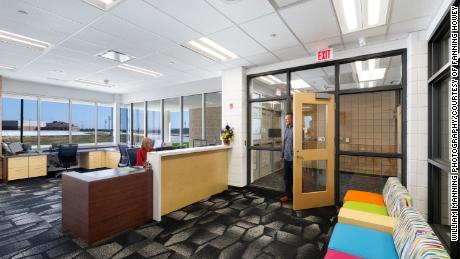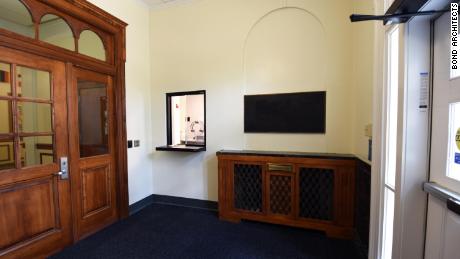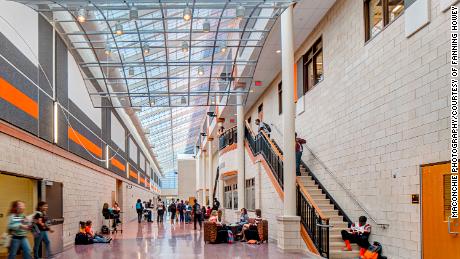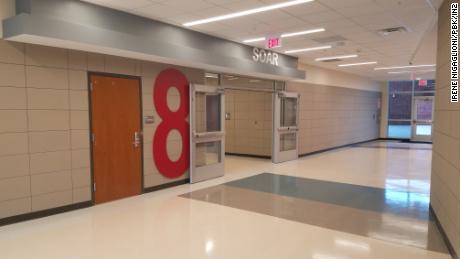Metal detectors? More resource officers? Armed teachers? Bulletproof backpacks? These security steps, whether effective or not, don't address the fundamental way that a school works or how people move through it. They also must be balanced with the need to create an environment where kids feel inspired and energized to learn.As students at Marjory Stoneman Douglas High School and across the country return to classes this week, CNN spoke to designers, architects and security experts to answer a sobering question: How do you design a school in the age of the mass shooting?Their answers, which follow a theory known as Crime Prevention Through Environmental Design, illuminate the delicate balance between security and education."It should be inspiring space. It should be lit with daylight. It should be a place where everyone feels welcome," said Sue Pruchnicki, principal at Bond Architects, a St. Louis firm that has designed many new schools."Our task is to make it safer without making it look like a fortress."
Perimeter landscaping that makes visitors visible
One main idea of designing safety is to create several layers of security, or concentric rings of access, starting with the perimeter and then working inward into the school. If there is an intruder, each layer of security is designed to delay him or her until first responders can arrive.The outermost layer of security is the landscape leading up to the entrance. Designers said they try to create a perimeter where everyone has to walk up on foot, so that people inside the school can easily see who is coming."Folks have to come up on a pedestrian level," said Art Bond, principal of Bond Architects.In practice, that means the area around the entrance might have a pathway through a low shrubbery or a garden, so that there are no places to hide. Some schools might have a pedestrian bridge out front to funnel visitors to that main entrance.In addition, visitor parking lots and bus dropoffs are located in separate areas further from the school entrance, so visitors have to walk to the entrance. Bollards or strategically placed planters near the entrance can also be used to prevent someone driving into the building."We want to make sure that we have lots of windows so that administrators, people that are in charge, can see folks approaching the building," said Bill Payne, CEO of architecture and design firm Fanning Howey.
A single entrance point
 After the shooting at Santa Fe High School in May, Texas Lt. Gov. Dan Patrick blamed the shooting on "too many entrances and too many exits" at the school.The comment was mocked by some as "door control," but he was making a real point: Many new schools are now built with a single, primary entrance that all students, teachers and visitors must come through."In design, what we want to make sure is that we can visually observe anybody that approaches the building and then pass them through a filtering process," Payne explained.The idea is to have a better way to control who visits the schools and, in the case of an emergency, to create an additional barrier to anyone seeking to do harm.Architects are designing schools where visitors encounter a single entrance point in a vestibule or antechamber. The visitors then must talk to an administrator or secretary to present their ID and reason for being there, and only then are they allowed to pass through another set of doors to get into the school.For example, the firm Fanning Howey built the West Muskingum Learning Center in Zanesville, Ohio with a vestibule that leads visitors to a front office.Ken Trump, the president of National School Safety and Security Services, said the vestibules help with what's called "visitor management.""You reconfigure the front entrance way of the school, so instead of being able to just walk right in to the school, you get funneled to the office to get checked in," he said.These vestibule doors are generally left open during the morning and afternoon rush and then closed once classes begin. There are also many one-way exits around the school that can be opened in case of a fire or other emergency."One way in, multiple ways out," Payne said.
After the shooting at Santa Fe High School in May, Texas Lt. Gov. Dan Patrick blamed the shooting on "too many entrances and too many exits" at the school.The comment was mocked by some as "door control," but he was making a real point: Many new schools are now built with a single, primary entrance that all students, teachers and visitors must come through."In design, what we want to make sure is that we can visually observe anybody that approaches the building and then pass them through a filtering process," Payne explained.The idea is to have a better way to control who visits the schools and, in the case of an emergency, to create an additional barrier to anyone seeking to do harm.Architects are designing schools where visitors encounter a single entrance point in a vestibule or antechamber. The visitors then must talk to an administrator or secretary to present their ID and reason for being there, and only then are they allowed to pass through another set of doors to get into the school.For example, the firm Fanning Howey built the West Muskingum Learning Center in Zanesville, Ohio with a vestibule that leads visitors to a front office.Ken Trump, the president of National School Safety and Security Services, said the vestibules help with what's called "visitor management.""You reconfigure the front entrance way of the school, so instead of being able to just walk right in to the school, you get funneled to the office to get checked in," he said.These vestibule doors are generally left open during the morning and afternoon rush and then closed once classes begin. There are also many one-way exits around the school that can be opened in case of a fire or other emergency."One way in, multiple ways out," Payne said.
Reinforced doors
 During the Sandy Hook shooting, the gunman used an assault weapon to shoot through the vestibule glass and enter the building.With that in mind, some schools are strengthening the glass and reinforcing the doors of their entrances to make the school a "harder" target for any intruder.That has become a robust market for some businesses. Total Security Solutions is a company that designs, plans and produces bullet resistant barriers for schools — but in a way that keeps the doors from looking too intimidating."We try to do that in a way that blends into the architecture, something that's visually pleasing, that doesn't look like Fort Knox or prison," said Rick Reid, market segment leader with Total Security Solutions.Reinforcing every single door in the school isn't tenable or cost effective, he said. Total Security Solutions mainly works to reinforce the vestibule at the single entrance point of the school.Other designers add a security film to the glass in the vestibule entrance with the idea of slowing down an intruder. The security film, although not bulletproof, keeps the glass in its frame like a car windshield, so intruders can't simply shatter the glass and walk right into the school."It's gonna take them longer to (enter), and by then, hopefully someone notices and somebody puts the building in lockdown so that police can be on their way," said Irene Nigaglioni, president of IN2 Architecture.The vestibules and hardened doors can also host metal detectors. However, their use remains a fraught issue among designers and security experts who say metal detectors may not be helpful in stopping an intruder and create unintended consequences, such as logjams. More importantly, they say, metal detectors send the wrong message to students."To me, there's a very negative message that is sent when you walk into your school building through metal detectors," Nigaglioni said. "It just doesn't send that (message of) 'This is a safe and welcoming place' that you need to learn."
During the Sandy Hook shooting, the gunman used an assault weapon to shoot through the vestibule glass and enter the building.With that in mind, some schools are strengthening the glass and reinforcing the doors of their entrances to make the school a "harder" target for any intruder.That has become a robust market for some businesses. Total Security Solutions is a company that designs, plans and produces bullet resistant barriers for schools — but in a way that keeps the doors from looking too intimidating."We try to do that in a way that blends into the architecture, something that's visually pleasing, that doesn't look like Fort Knox or prison," said Rick Reid, market segment leader with Total Security Solutions.Reinforcing every single door in the school isn't tenable or cost effective, he said. Total Security Solutions mainly works to reinforce the vestibule at the single entrance point of the school.Other designers add a security film to the glass in the vestibule entrance with the idea of slowing down an intruder. The security film, although not bulletproof, keeps the glass in its frame like a car windshield, so intruders can't simply shatter the glass and walk right into the school."It's gonna take them longer to (enter), and by then, hopefully someone notices and somebody puts the building in lockdown so that police can be on their way," said Irene Nigaglioni, president of IN2 Architecture.The vestibules and hardened doors can also host metal detectors. However, their use remains a fraught issue among designers and security experts who say metal detectors may not be helpful in stopping an intruder and create unintended consequences, such as logjams. More importantly, they say, metal detectors send the wrong message to students."To me, there's a very negative message that is sent when you walk into your school building through metal detectors," Nigaglioni said. "It just doesn't send that (message of) 'This is a safe and welcoming place' that you need to learn."
Wider, open hallways
 New schools also are being designed with wide, open hallways that provide clear lines of sight. This gives teachers, administrators and school resource officers the ability to stand at one spot and see what's going on all around. Having open hallways without nooks and crannies also gives surveillance cameras a fuller view of the school.In modern schools, these hallways function as throughways as well as collaborative working spaces similar to a Starbucks, Nigaglioni said. These open hallways also can be sealed off electronically in the case of an emergency, adding one more layer of security. In a lockdown, students would go to their classrooms and lock that door, too, creating yet another barrier.The overall idea is to create a collaborative learning environment that can function as another zone of security to allow time for police to arrive.
New schools also are being designed with wide, open hallways that provide clear lines of sight. This gives teachers, administrators and school resource officers the ability to stand at one spot and see what's going on all around. Having open hallways without nooks and crannies also gives surveillance cameras a fuller view of the school.In modern schools, these hallways function as throughways as well as collaborative working spaces similar to a Starbucks, Nigaglioni said. These open hallways also can be sealed off electronically in the case of an emergency, adding one more layer of security. In a lockdown, students would go to their classrooms and lock that door, too, creating yet another barrier.The overall idea is to create a collaborative learning environment that can function as another zone of security to allow time for police to arrive. "That hardened approach, where everybody's in enclosed little silos, is not what we're attempting to do," Payne said. "We're more interested in keeping the perpetrator or attacker at bay so the first responders can arrive in time."Pruchnicki, of Bond Architects, said that classrooms are now labeled with large numbers that jut out from the wall. That makes it easier for first responders — not to mention new students or substitute teachers — to quickly locate a specific room on the school's campus.Of course, school security is much more than just the threat of active shootings. Schools also have to deal with bullying, sexual assaults, weather emergencies and estranged parents — say, in a custody battle — who may want to pull their kids out of school. The newest school designs have multiple focuses to address all of these issues."On a day-to-day basis, you want to design schools and focus on things that will help with monitoring, with supervision and communication, dealing with bullying prevention and those types of issues," Trump said. "They go beyond just the tunnel vision focus on a shooter."
"That hardened approach, where everybody's in enclosed little silos, is not what we're attempting to do," Payne said. "We're more interested in keeping the perpetrator or attacker at bay so the first responders can arrive in time."Pruchnicki, of Bond Architects, said that classrooms are now labeled with large numbers that jut out from the wall. That makes it easier for first responders — not to mention new students or substitute teachers — to quickly locate a specific room on the school's campus.Of course, school security is much more than just the threat of active shootings. Schools also have to deal with bullying, sexual assaults, weather emergencies and estranged parents — say, in a custody battle — who may want to pull their kids out of school. The newest school designs have multiple focuses to address all of these issues."On a day-to-day basis, you want to design schools and focus on things that will help with monitoring, with supervision and communication, dealing with bullying prevention and those types of issues," Trump said. "They go beyond just the tunnel vision focus on a shooter."
Original Article
[contf] [contfnew] 
CNN
[contfnewc] [contfnewc]






